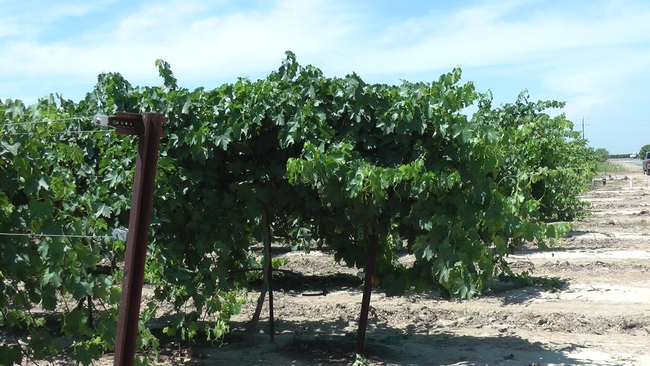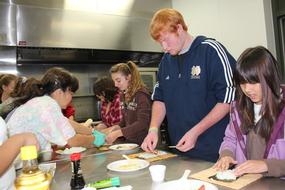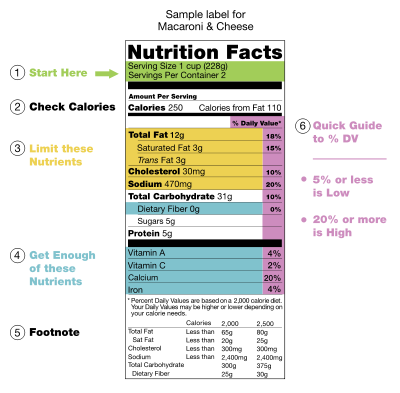UC Food Blog
Kitchen table memories
Not long ago, a friend asked several of us to jot down some memories about the kitchen tables in our lives. The operating premise of the exercise was that food is central to our relationships, and that much of life occurs around the places where we eat, and those we choose to eat with.
My kitchen table memories are varied. My family moved quite frequently when I was young: our kitchen table was a sort of “movable feast.” In my faith tradition, this term has a very specific meaning that informs my attitudes toward food. (For the very literary minded, it is also the title of a wonderful memoir written by Ernest Hemingway late in his life).
I have wonderful memories about kitchen tables. In our home near Philadelphia, I remember my older sister sitting at the table in the spacious kitchen, trying to cajole me to eat more before we went to church. I was served the best pancakes I’ve ever eaten at that very table. It was at this table where my brother once committed the serious transgression of launching scrambled eggs at my sister, using his fork as the springboard. (This happened exactly once.) A few years later, in the San Fernando Valley, close by some citrus orchards where the California State University campus now stands, I recall eating wonderful meals at our new home, which featured a formal dining room, where my parents proudly used the plastic fruit I’d bought them as a gift as the table’s centerpiece.
I remember my Grandmother Eloise’s elegantly appointed dining room table in Clinton, Miss., where we always drank heavily sugared iced tea from the tallest glasses I'd ever seen, being certain to clink the ice with long handled silver spoons. My grandmother’s was the most modern kitchen I’d ever seen, and she dressed up for every meal. Only a few miles away, in Jackson, we also took supper with my other grandparents, RJ and Pauline, at their kitchen table in a modest home on a quiet tree-lined street. These grandparents, raised in a small rural community, fed us homegrown sliced tomatoes, stewed okra, skillet cornbread, fish caught by my grandfather, and bowls of steaming hot (and spicy!) gumbo.
I also remember the dinette set in my family’s small camping trailer, where my dad prepared and fed his kids Kraft Mac & Cheese and tuna fish. (Different food generation, but great dad!) It was also the table where we played board games and cards by lantern light, watching the Firefall at Yosemite Park. After dinner, games and a soothing cup of hot chocolate, the dinette set was folded down and became the bed I slept on.
When my husband and I got our first apartment, we went to a used furniture store called Egypt's and bought a tiny bowed kitchen table. It was constructed of particleboard and covered with faux wood laminate. We used it for years. It was where we prepared our budget-wise home cooked meals every night, clipped coupons and prepared for graduate exams.
When we bought our home, we found ourselves with more space, but little cash to furnish it. While visiting a second-hand store in our tiny downtown, we fell in love with a large, heavy table. It was a little dinged up, was missing the leaves, but clearly had been loved by a large family. It featured an extra set of legs in the middle of the table, meant to support it at its grand length when fully extended. We paid what was for us a small fortune to purchase the table, and got friends to help us move it. We had no chairs, so a friend gave us three turn-of-the-(last)-century chairs salvaged from the U.S. Maritime Commission Office in Long Beach. They don't match the table or each other, but we've never cared and have kept them. They are simply marvelous.
We live in a small home, so our table serves as both kitchen and dining room table, just a foot or so from the counter and the stove. While a smaller table might make more sense, I'd never let this one go. We refinished it several years ago, and it turns out that it's quite an unusual and valuable table, worth many, many times what we paid for it.
It's certainly priceless to me, mostly because it's anchored our family in this house. As the child of movable tables and movable feasts, I've found its constant presence uniquely reassuring. It's where we prepare food and school projects and where I do much of my writing. It's where I sat my daughter and bandaged her first skinned knee. It’s where the three of us share breakfast together every morning. Where we’ve hosted birthday and holiday celebrations, team parties, teen gatherings, study groups and committee meetings (all involving good food and good people). Where we’ve had important family discussions, shared memories, and laughed. It's where my husband reads the sports page, where I fume over the editorial page, and where my daughter and I craft and sew. It's sited between two windows three feet from our side fence, where honeysuckle grows lush and fragrant, and where the poinsettia transplanted from our neighbor’s yard more than 20 years ago blooms brightly.
The kitchen table hosts ever-changing coverings. A tablecloth given to us by friends after their trip to Guatemala. Another one made by my sister, with matching napkins. An antique lace cloth I found in a small store near home. On very special occasions, we let the wood speak for itself.
I don't know the history of the table before it joined our family, but it has claimed a central place in our family's history. After we purchased this table, the table we purchased from Egypt’s was recycled to hold an ever-growing collection of plants. It finally expired a few years ago. I was sad to see it go.
Have a safe and happy summer, filled with healthy and delicious food, eaten at tables you love, with those you cherish.
Vintner creates interesting new wines from research grapes
Nearly half of the 55 unusual winegrape varieties in a plot at the UC Kearney Agricultural Research and Extension Center in Parlier displayed enough promising characteristics to prompt a cooperating vintner to make 25 small lots of wine.
The research at Kearney is designed to expand the wine industry’s options in the San Joaquin Valley, currently California’s top grape growing district in terms of production, but lowest in terms of price.
“Most of the popular wine varietals – Merlot, Cabernet Sauvignon, Chardonnay – are at their best in somewhat cooler climates. So we are looking for grapes that make superior fruit in warm climates,” said Matthew Fidelibus, UC Cooperative Extension specialist in the Department of Viticulture and Enology at UC Davis.
Fidelibus is supervising the production at Kearney of winegrape varieties that were collected from countries such as Spain, Greece and Italy, where the climate mimics the valley’s hot days and warm evenings. In the research plot, the vines exhibit a wide range of vigor, productivity and fruit quality.
While Fidelibus is gathering data on each variety’s yield potential, cluster architecture, amenability to mechanization and other viticultural characteristics, winemaker Constellation Brands is monitoring the winegrapes’ potential to produce distinctive, flavorful California wines.
“We need a breakthrough variety,” said Oren Kaye, a research and development winemaker at Constellation Brands. “Many of the wines we produced showed significant promise.”
Currently, 80 percent of California wine is made from fewer than 10 types of winegrapes, with the most popular white being Chardonnay and the most popular red Cabernet Sauvignon.
Kaye says the market is ripe for something new, perhaps Fianio, a white wine with a fresh, young style evoking flavors of melon and grapefruit, or the stylistically unique Marselan Noir, a red wine with bright cherry flavor that pops.
“Millennials own tomorrow,” Kaye said. “They are more accepting of things that are new, as long as it is good. At a restaurant, they think nothing of pulling out a smart phone to look up a wine they haven’t heard of before.”
Fidelibus comments in the video below about a recent tasting event that featured four winegrape varieties from the Kearney trial:
New wine varietals
Fairground farms & farmyard festivals
Do county fairs make you think of deep-fried Twinkies and Ferris wheels, and maybe some prize-winning pigs? Can you imagine a local food marketplace next to the quilt show, a demonstration farm by the pony rides, fresh fruit for sale in the midway, a community dinner honoring local farmers, and housing available for hundreds of farm-workers the week after the fair closes?
These all thrive at some of California's county and district fairs, and may be part of the future at many others soon. The University of California small farm program and the California Department of Food and Agriculture (CDFA) Division of Fairs and Expositions are teaming up to connect fruit, vegetable, nut and flower farmers with county and regional fairs to celebrate California specialty crops and encourage agritourism. Fair organizers also hope to develop new partnerships that help support the fairs - particularly important now as the fairs have recently lost funding due to state budget cuts.
“We look forward to working with CDFA’s Division of Fairs and Expositions to expand agritourism opportunities; this will expand revenue sources for California’s small farmers,” said Shermain Hardesty, UC Cooperative Extension specialist in the UC Davis Department of Agricultural and Resource Economics. Hardesty leads the UC small farm program.
Together we are organizing workshops and tours for farmers and agricultural leaders at seven different fairs throughout the state, to be held during fair time in the 2012 fair season. We're calling the project "Fairground Farms and Farmyard Festivals; Showcasing California Specialty Crops."
Each workshop will be a little different, because each of the fairs has it's own unique history and community. We'll hear fair officials sharing with farmers some of their methods for safely entertaining and feeding thousands of people. We'll have presentations by farmers currently involved with local fairs or local agritourism, interactive discussions on potential collaborations between specialty crop growers, agritourism operators and fairs, and guided tours of the fair facilities.
At the first workshop, held at the Shasta District Fair in Anderson on June 14, fair leaders from several Northern California fairs listened to Tehama County Farm Bureau leader Kari Dodd explain how she had helped set up the marketplace for local growers at the Tehama County Fair. Then they discussed how to set such a program up at their own fairs. Other ideas raised by the group included demonstration farms and gardens, greenhouses, year-round restaurants and rental kitchens at the fair grounds, and local food events.
The next workshop and tour will be Thursday July 26 at the Amador County Fair in Plymouth, hosted by Fair CEO Troy Bowers. At this event we will hear from Mountain Mandarin Festival organizer and cookbook author Joanne Neft, as well as from representatives of Farms of Amador, Amador County Grape Growers, and MotherLode Harvest, who all participate in the Amador Fair. Following Amador, we visit Ventura, Napa, Yolo, Santa Cruz and Fresno.
Registration for all of the workshops is now open. We welcome farmers and fair leaders from surrounding counties to each fair workshop, as well as county agricultural commissioners, Farm Bureau leaders, tourism professionals, farm advisors and educators, fair and festival vendors and entertainers and agritourism operators interested in new partnerships.
Let's talk!
The workshop schedule:
Thursday, July 26 - Amador County Fair, Plymouth
Thursday, August 2 - Ventura County Fair, Ventura
Thursday, August 9 - Napa Town & Country Fair, Napa
Thursday, August 16 - Yolo County Fair, Woodland
Thursday, September 13 - Santa Cruz County Fair, Watsonville
Thursday, October 4 - Big Fresno Fair, Fresno
For registration and more information about the events is online or call Penny Leff at (530) 752-7779
See you at the fair!
Don't blame the Farm Bill for obesity
America’s rising obesity rates are exacting a high cost on society. In looking for solutions, many people blame federal farm subsidies for the current obesity problems. The Farm Bill is up for reauthorization this year. As Congress considers changes, I think it is important to understand that the Farm Bill is not to blame for America’s increasing weight gain.
It may seem obvious that subsidies make certain foods cheaper, therefore contributing to overconsumption, but every serious analysis of the relationship by economists has found the notion untrue. In fact, U.S. farm policies have had generally modest and mixed effects on prices and quantities of farm commodities; the overall effect on the prices paid by U.S. consumers for food has been negligible; consequently, eliminating farm policies would have a negligible influence on dietary patterns and obesity.
Farm subsidies have at times resulted in lower U.S. prices of some farm commodities, such as certain food grains or feed grains, and consequently lower costs of producing breakfast cereal, bread, or livestock products. But in these cases, the price-depressing (and consumption-enhancing) effect of subsidies has been contained (or even reversed) by the imposition of additional policies that restricted acreage or production. In addition, for more than a decade, about half of the total subsidy payments have provided limited incentives to increase production because the amounts paid to producers were based on past acreage and yields rather than current production. Moreover, for the commodities that are subject to U.S. import barriers, the effect of the policy is to increase farm and food prices domestically, providing a disincentive to consume foods that use these commodities as ingredients. Trade barriers that apply to imported sugar, dairy, orange juice and beef cause the prices of these agricultural commodities to increase, and thereby increase the cost and discourage consumption of foods that use these commodities.
What about corn? Farm subsidies are responsible for the growth in the use of corn to produce high fructose corn syrup (HFCS) as a caloric sweetener, but not in the way it is often suggested. The culprit here is not corn subsidies; rather, it is sugar policy that has restricted imports, driven up the U.S. price of sugar and encouraged consumers and food manufacturers to replace sugar with alternative caloric sweeteners, especially HFCS. Combining the sugar policy with the corn policy, the net effect of farm subsidies has been to increase the price of caloric sweeteners generally, and to discourage total consumption while causing a shift in sweetener use between sugar and HFCS. This discouragement has been enhanced recently by U.S. biofuels policy. The current U.S. ethanol policy benefits U.S. corn growers by driving up the demand for corn as feedstock. This effective subsidy to corn growers much more than offsets any impact of other farm policies that might increase the availability of corn for use in food and livestock feed. So the overall effect of the full set of policies is to make all of the corn-based food products more expensive, not less expensive to consumers.
Even if the effects of policy on the prices of farm commodities were large and in a direction that would contribute to obesity, the ultimate impacts on food prices would be comparatively small. Farm commodities used as ingredients represent a small share of the total cost of retail food products, and this share has been shrinking for all farm commodities over the past three decades. On average the farm commodity cost share is approximately 20 percent, but it varies widely: for grains, sugar, and oilseeds, it is less than 10 percent; for soda, a food product that is often associated with obesity, the share is approximately 2 percent.
U.S. farm policies might well be seen as unfair and inefficient. But whether we like these policies or not for other reasons, their effects on obesity are negligible. Farm subsidies are a red herring in the obesity context just as obesity is a red herring in the context of farm subsidy policy. Our careful quantitative analysis of these issues indicates that U.S. farm subsidy policies, for the most part, have not made food commodities significantly cheaper and have not had a significant effect on caloric consumption. In fact, eliminating all farm subsidies, including those provided indirectly by trade barriers, may, if anything, lead to an increase in annual per capita consumption of calories and an increase in body weight. Farm policies have more likely slowed the rise in obesity in the United States—but any such effects must be small. Compared with other factors, the policy-induced differences in relative prices of farm commodities have played only a tiny role in determining excess food consumption and obesity in the United States.
Julian Alston is a Professor in the Department of Agricultural and Resource Economics at the University of California, Davis, and a member of the University of California’s Giannini Foundation of Agricultural Economics.
Food truth that we can eat
What we know about eating, not eating and overeating has been investigated by research universities and university-trained scientists since the 1920s. The Journal of Nutrition began publishing in 1928. Now 2.5 million inquiries each month probe a massive body of knowledge about the nature of our evolving physical and cultural relationship with food, with at least 30 more food and nutrition journals collecting and dispersing this science globally.
The result: Americans spend more time debating what to eat than at any other time in history. The firmly held beliefs of most adults about what should be eaten or avoided have origins in the history of this science. In spite of the intent of this research, and because it is frequently challenged, people are understandably skeptical or easily recruited to the next food fad.
As a food science graduate and later as a campus writer, I have worked smack in the center of a leading food research university for more than a decade. This vantage point allowed me to follow the path of these rivulets of research as they flow through scientific journals and later become diluted by commercial interests. They readily dribble to the media without interpretation or the full context of their intended purpose.
Perhaps the most sacred form of long-term research evidence we follow is the food label, an abbreviated version of truth that empowers our choice to follow our closely held beliefs. University research and methods also indirectly determine what will appear on labels in the future. I have long admired the pragmatic ethics of Barbara Schneeman, who taught me as a professor of nutrition and college dean before going to the U.S. Food and Drug Administration to direct the redesign of nutritional food labeling (and other regulations).
Meanwhile, efforts in the national “food court” to hold advertising accountable to the truth are gaining momentum. In spite being misused, universities remain the best source of food truth. This assumes that faculty remains free to challenge the truth and that research funds are available to validate it. Unfortunately, funding for food research is shrinking along with the federal budget, and the federal agencies responsible are seeing an increase in applications for what remains. This week, the National Research Council will release their report , Research Universities and the Future of America: Ten Breakthrough Actions Vital to Our Nation's Prosperity and Security. The report will attempt to list the top 10 actions that Congress, the federal government, states and research universities could take to assure that American research universities help the U.S. “compete, prosper, and achieve national goals for health, energy, the environment, and security in the global community.” Those of us who are watching can only hope that the food truth needed to challenge nutritional hype will be on that list.








